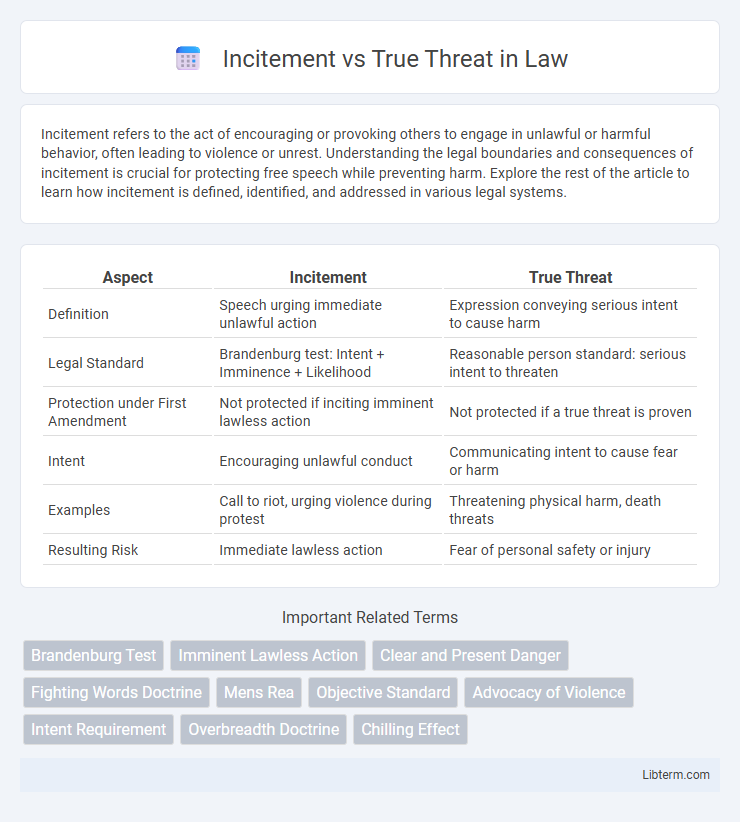Incitement refers to the act of encouraging or provoking others to engage in unlawful or harmful behavior, often leading to violence or unrest. Understanding the legal boundaries and consequences of incitement is crucial for protecting free speech while preventing harm. Explore the rest of the article to learn how incitement is defined, identified, and addressed in various legal systems.
Table of Comparison
| Aspect | Incitement | True Threat |
|---|---|---|
| Definition | Speech urging immediate unlawful action | Expression conveying serious intent to cause harm |
| Legal Standard | Brandenburg test: Intent + Imminence + Likelihood | Reasonable person standard: serious intent to threaten |
| Protection under First Amendment | Not protected if inciting imminent lawless action | Not protected if a true threat is proven |
| Intent | Encouraging unlawful conduct | Communicating intent to cause fear or harm |
| Examples | Call to riot, urging violence during protest | Threatening physical harm, death threats |
| Resulting Risk | Immediate lawless action | Fear of personal safety or injury |
Understanding Incitement vs. True Threat
Incitement involves speech intended to provoke imminent lawless action, meeting the clear and present danger standard established by Brandenburg v. Ohio, whereas true threats consist of statements meant to communicate an intent to commit violence against an individual or group. Courts differentiate incitement by evaluating the immediacy and likelihood of unlawful acts, while true threats hinge on the perception of fear or intimidation by the target. Understanding the legal nuances between incitement and true threats is essential for balancing First Amendment protections with public safety concerns.
Legal Definitions and Key Differences
Incitement involves speech urging others to engage in imminent lawless action, requiring intent and a high likelihood of producing such action under the Brandenburg v. Ohio standard. True threat refers to statements meant to intimidate or place individuals in fear of bodily harm, examined under the "reasonable person" standard for perceived threat. The key legal difference is incitement targets collective unlawful acts with immediate effect, whereas true threats focus on personal fear of violence without necessitating imminent action.
Historical Context and Landmark Cases
The legal distinction between incitement and true threat has evolved significantly through landmark cases such as Brandenburg v. Ohio (1969), which established the incitement standard requiring imminent lawless action, and Virginia v. Black (2003), which clarified the boundaries of true threats by emphasizing the intent to instill fear. Historically, these doctrines emerged from the need to protect free speech under the First Amendment while preventing speech that poses immediate harm or fear. This nuanced balance continues to shape constitutional law, influencing how courts assess speech-related offenses.
First Amendment Protections and Limitations
The First Amendment safeguards free speech but draws clear lines between incitement and true threats, each subject to distinct legal limits. Incitement involves speech intended to provoke imminent lawless action and lacks protection when it is likely to produce such action, as established in Brandenburg v. Ohio. True threats encompass statements meant to intimidate or cause fear of violence against individuals or groups, allowing the government to restrict speech that poses a genuine risk of harm without requiring proof of imminent lawless action.
The Brandenburg Test for Incitement
The Brandenburg Test for Incitement requires speech to be directed to inciting imminent lawless action and likely to produce such action, establishing a high threshold for prosecuting incitement under the First Amendment. True Threats differ as they involve statements meant to intimidate or cause fear of bodily harm, not protected by free speech rights. Understanding this distinction is crucial for navigating legal boundaries between protected expression and punishable unlawful threats.
How Courts Identify a True Threat
Courts identify a true threat by assessing whether a reasonable person would interpret the statement as a serious expression of intent to harm or cause violence against an individual or group. The evaluation involves analyzing the context, speaker's intent, and the statement's potential to instill fear of bodily harm or death. Unlike incitement, which requires urging imminent lawless action, true threats focus on the perceived menace and the protection of individuals from fear and potential violence.
Social Media and Modern Communication Challenges
Incitement involves speech that is intended and likely to provoke imminent illegal actions, while true threats refer to statements meant to intimidate or cause fear of violence. Social media platforms amplify challenges in distinguishing incitement from true threats due to rapid information spread and ambiguous context. Legal systems struggle to balance free expression with public safety as digital communication blurs the lines between protected speech and punishable conduct.
Real-World Examples: Case Studies
Real-world examples distinguish incitement from true threats through judicial rulings that clarify intent and imminence of harm. In Brandenburg v. Ohio (1969), the Supreme Court protected speech advocating illegal action unless it incites imminent lawless activity. Conversely, Virginia v. Black (2003) upheld restrictions on cross burning as a true threat due to its intent to intimidate, illustrating the legal boundaries between protected speech and punishable threats.
Implications for Free Speech and Public Safety
Incitement involves speech intended to provoke imminent lawless action, posing clear risks to public safety, while true threats consist of statements meant to intimidate or cause fear of violence, directly impacting individual security. Courts balance these categories by restricting speech that endangers public order without undermining constitutional free speech protections. The legal distinction influences how authorities address harmful rhetoric while safeguarding democratic expression and maintaining societal safety.
Best Practices for Navigating Legal Boundaries
Understanding the distinction between incitement and true threat is crucial for legal compliance and free speech protection. Incitement involves speech that is intended and likely to produce imminent lawless action, while a true threat refers to expressions meant to intimidate or instill fear of bodily harm. Best practices include clearly defining context, intent, and immediacy when evaluating statements, implementing training on legal standards for communication, and consulting legal experts to ensure speech does not cross into illegal territory.
Incitement Infographic

 libterm.com
libterm.com